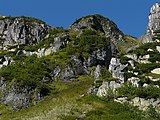Śnieżne Kotły
Coordinates: 50 ° 46 ′ 50 ″ N , 15 ° 33 ′ 30 ″ E
The Śnieżne Kotły (German snow pits , Czech. Sněžné jámy ) are two glacier cirques in the western Giant Mountains in Poland near the border with the Czech Republic . They are a unique example of the alpine character of the landscape of the low mountain range.
location
Both basins are located between the Hohen Rad ( 1509 m ) and the Veilchenstein ( 1471 m ) in the district of Piechowice ( Petersdorf ). The Small Snow Pit (Polish: Mały Śnieżny Kocioł ) on the northern slope is 550 m long and 400 m wide. The Great Snow Pit (Polish: Wielki Śnieżny Kocioł ) on the eastern slope is 800 m long and 600 m wide. The rock walls of the cirque drop steeply 200 m and are bordered by end and side moraines at heights of 860 to 900 meters . Between them lies the rubble of a ground moraine that reaches a maximum height of 15 meters. At the lower edges of the cirque there are several smaller lakes, the so-called Sniezne Stawki ( Kochelteiche ). Since they are only 1.5 meters deep, they regularly dry out into swampy areas during the warm season.
Emergence
The bowl-shaped valleys and moraines were created by the activity of Ice Age glaciers and were formed during the Pleistocene , probably during the last glacial period . In addition to the karen at the Big and Small Pond , the snow pits form the most perfect cirques that can be found on the Polish side of the Giant Mountains.
flora
There is a geological peculiarity in the small snow pit, through whose steep granite slopes two clearly visible 30-60 meter wide and 120 meter long basalt veins run up to a height of 1425 m . These rock dikes probably represent the highest basalt deposit in all of Central Europe.
Many of the plants growing here are particularly tied to this rock occurrence, because the mineral-rich basalt enabled the emergence of the most biodiverse place in the Giant Mountains in terms of flora. The snow saxifrage (Saxifraga nivalis) grows here , a species endemic to Central Europe , the only subspecies of the moor saxifrage (Saxifraga moschata basaltica) and the Alpine winter fern (Woodsia alpina) in the world.
In the remaining area of the snow pits there are also numerous rare species of alpine flora such as the alpine pasque flower (Pulsatilla alpina), the dwarf primrose (Primula minima), the Sudeten monkshood (Aconitum plicatum), the mountain rose (Rosa pendulina), alpine milk lettuce (Cicerbita alpina) and the moss bell (Linnaea borealis) , an Ice Age relic .
fauna
Witnesses of the Ice Age can often be found in the Giant Mountains, for example the Arctic diaper snail (Vertigo modesta), which has ideal living conditions here in the scree fields overgrown by plants. And of course, birds such as the Alpine Brownelle (Prunella collaris) and the Ring Thrush (Turdus torquatus) also live here .
natural reserve
The snow pits were one of the first areas in the Sudetes to be established to protect rare flora and fauna. They have had the status of a nature reserve since 1933 and are now part of the Polish National Park Karkonoski Park Narodowy (KPN).
tourism
The snow pits are dominated by the Rübezahlkanzel ( Czarcia Ambona ) ( 1497 m ). This rock group with the wool sack weathering typical of the Krkonoše Mountains can be climbed via steps and offers an impressive view as well as a bit of thrill, because the rock faces plunge straight down over 100 meters below the viewpoint.
Next to it, at an altitude of 1490 m , is the television and radio station R adiowo- T elewizyjny O środek N adawczy RTON Śnieżnymi Kotłami, which is housed in the former Schronisko "Nad Śnieżnymi Kotłami" ( snow pit hut ). The origins of this building go back to 1835, when the first youth hostel was founded here at the beginning of tourism in the Giant Mountains through an initiative of Count Schaffgotsch .
The area around the snow pits is well developed for hikers and mountain bikers . These include several mining areas , which are connected by hiking trails such as the Główny Szlak Sudecki (Sudeten Main Hiking Trail), the Kammweg , now known as the Czech-Polish Friendship Trail, and the Coral Stone Trail . Mention should be made of the Martinova bouda ( Martinsbaude ) on the southern slope of the Hohen Rades, the Schronisko PTTK "Pod Łabskim Szczytem" ( Old Silesian Cottage ) on the northern slope and the Labská bouda ( Elbe falls ) on the southern slope of the Veilchenstein.
gallery
Web links
- The snow pits on szklarskaporeba.pl (German)
- Suggestion for a hike (with optional GPS data)
Individual evidence
- ^ Information from the Krkonoše Association ( Memento of December 11, 2014 in the Internet Archive )








